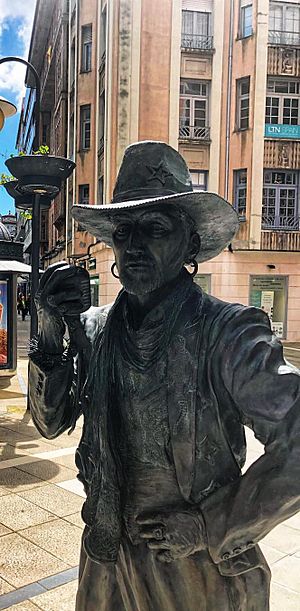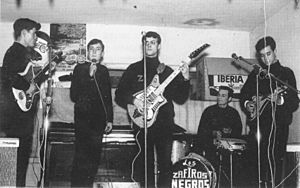Tino Casal facts for kids
Quick facts for kids
Tino Casal
|
|
|---|---|
 |
|
| Background information | |
| Birth name | José Celestino Casal Álvarez |
| Born | 11 February 1950 Oviedo, Asturias, Spain |
| Died | 22 September 1991 Madrid, Spain |
| Genres | Glam rock, Pop, Synth-pop |
| Occupation(s) | Singer |
| Instruments | Singing |
| Years active | 1963–1991 |
| Labels | EMI |
José Celestino Casal Álvarez, known to many as Tino Casal, was a famous Spanish singer, songwriter, and producer. He was born on February 11, 1950, in Tudela Veguín, Oviedo, Asturias, Spain. Tino Casal passed away on September 22, 1991, in Madrid, Spain.
He was a very popular artist in the 1980s in Spain. Tino Casal was a big part of a cultural movement called La Movida Madrileña (which means "The Madrid Movement"). He was known for his amazing and fancy costumes and stage shows, much like the famous performer Liberace.
Contents
Tino Casal's Life Story
Tino Casal started his music journey when he was just 13 years old. He joined a group called "Los Zafiros Negros" (The Black Sapphires). In 1967, he became part of another band, "Los Archiduques" (The Archdukes). He took over as their lead singer when the original singer got sick.
After that, Tino Casal traveled to London. He wanted to explore his love for painting there. In London, he discovered glam rock music. He was really inspired by artists like David Bowie, Sweet, and T. Rex.
Returning to Spain and Early Success
In 1977, Tino Casal came back to Spain. He signed a music contract with Philips. At this time, Spanish music fans were looking for new stars. During the 1970s, he performed at many music festivals. In 1978, he won "Best Young Singer" and "Best Musical Composition" at the Benidorm Festival.
After his contract ended, Casal focused on painting for a while. But in 1980, he returned to music. This time, he started producing other artists. He helped groups like Goma de Mascar and Obús, which was Spain's first heavy metal band. EMI record label noticed his talent for both singing and producing. They offered him a contract in 1981.
Becoming a Solo Star
With his new contract, Tino Casal had more freedom with his music. In 1981, he released his first solo album, Neocasal. This album included his first number one hit, "Champú de Huevo" (Egg Shampoo), and another popular song, "Billy Boy". Even though some critics didn't love the album, Tino Casal started gaining many fans.
He also kept producing records for other bands, like Azul y Negro. He even worked with the famous filmmaker Pedro Almodóvar. Tino Casal helped pay for Almodóvar's film Laberinto de pasiones (Labyrinth of Passion). Some of Tino Casal's famous looks, like his red jacket, came from this movie.
In 1983, Tino Casal released Etiqueta Negra. This album made him a huge star in Spain. It featured popular songs like "Embrujada" ("Bewitched") and "Póker para un perdedor" ("Poker for a Loser"). The album sold very well. The next year, he released "Hielo Rojo" ("Red Ice"), which included the hit song "Pánico en el edén" ("Panic in the Garden of Eden").
Facing Challenges and Comeback
In 1985, Tino Casal hurt his ankle badly while on tour in Valencia. He kept performing for two more months, even though doctors told him to rest. He took medicine to help with the pain. This made him very sick, and he ended up in the hospital. He was in the Intensive Care Unit for 19 days. He had a serious infection in his leg. After a long time, he slowly got better.
After recovering, Tino Casal made a big comeback in 1987. He released a new album called Lágrimas de cocodrilo (Crocodile Tears). He recorded this album at the famous Abbey Road Studios. The album had his own songs and new versions of other artists' songs. The biggest hit from this album was his cover of "Eloise" by Barry Ryan. It became a number one hit in Spain. In 1988, it was the second best-selling album in Spain.
In October 1989, he released his last album, Histeria. This album looked back at the music styles from his early career in the 1970s. After this, Tino Casal spent his time painting and sculpting. He also worked with other artists. In May 1991, he released a collection of his greatest hits, Etiqueta Negra, grandes éxitos. He was planning to record another album in Tokyo in 1992.
Tino Casal's Passing
Tino Casal sadly passed away on September 22, 1991, at the age of 41. He was in a car accident in Madrid. He was with three other people after dinner. They were going to a recording studio. It was raining, and the driver lost control of the car. The car crashed into a lamp post. Tino Casal was in the passenger seat and was the only person who died. He passed away while being taken to the hospital by helicopter. This news was a big shock to the music world in Spain.
A year later, EMI honored Tino Casal by re-releasing his greatest hits album, Etiqueta Negra. Many other artists, like Alaska, Marta Sánchez, and Stravaganzza, have covered or used parts of his songs to this day.
Tino Casal's Music Albums
- Neocasal (1981)
- Etiqueta Negra (1983)
- Hielo Rojo (1984)
- Lágrimas de Cocodrilo (1987)
- Histeria (1989)
Compilation Albums
- Grandes Éxitos: Etiqueta Negra (1991)
- Casal Vive (2000)
- Casal Remixes (2001)
- Casal Único: Antología Audiovisual (2006)
- Tino Casal: The Platinum Collection (2007)
- Todo Casal (2011)
- De la Piel del Diablo – La Colección Definitiva (2016)
See also
 In Spanish: Tino Casal para niños
In Spanish: Tino Casal para niños



